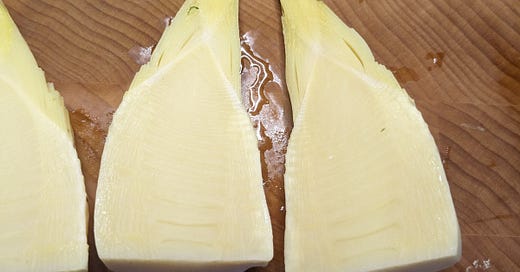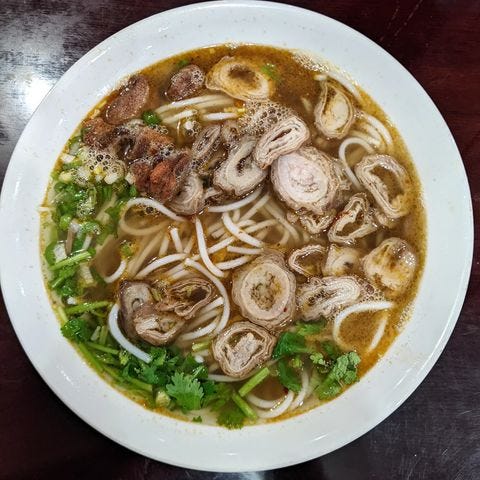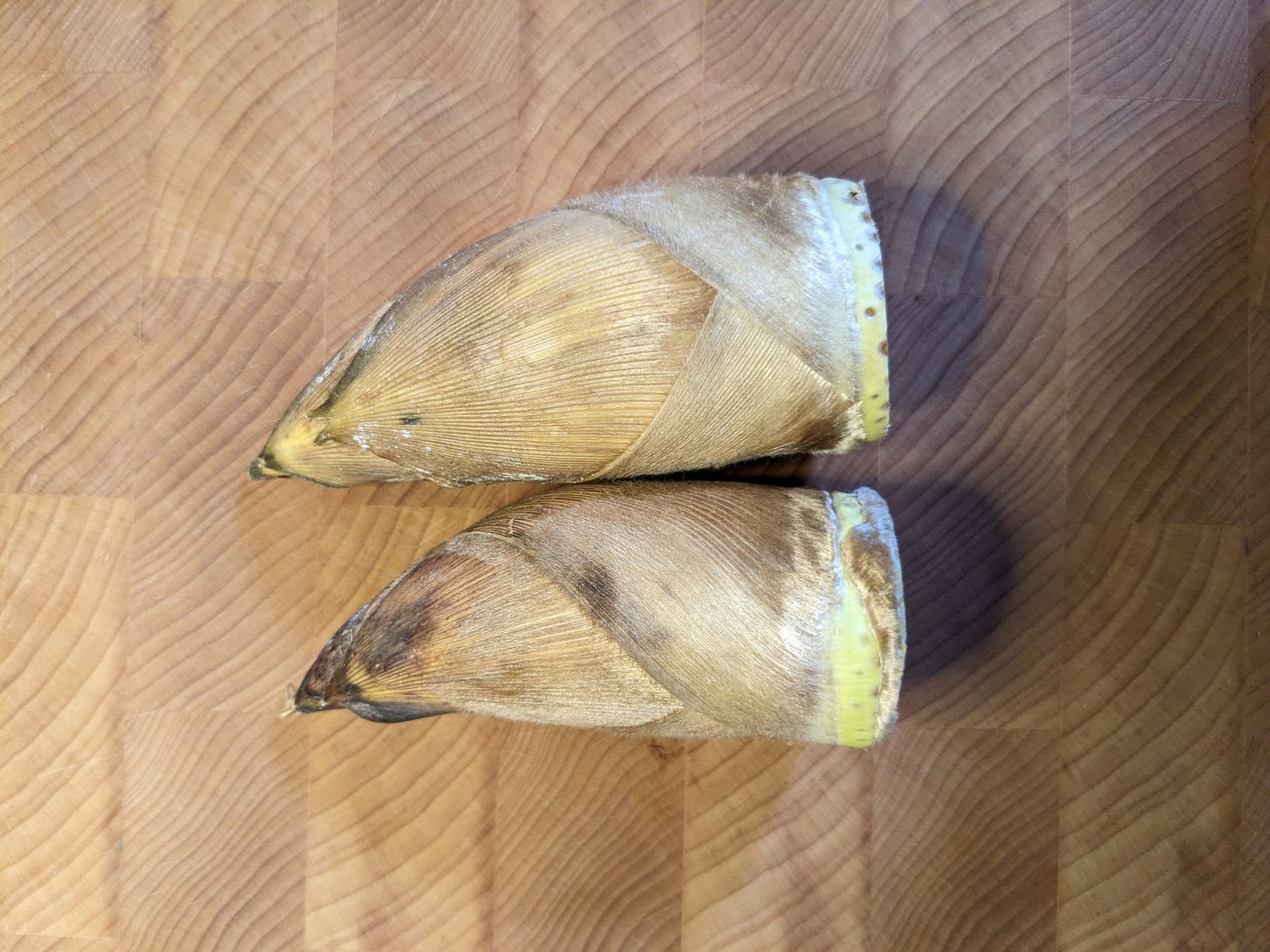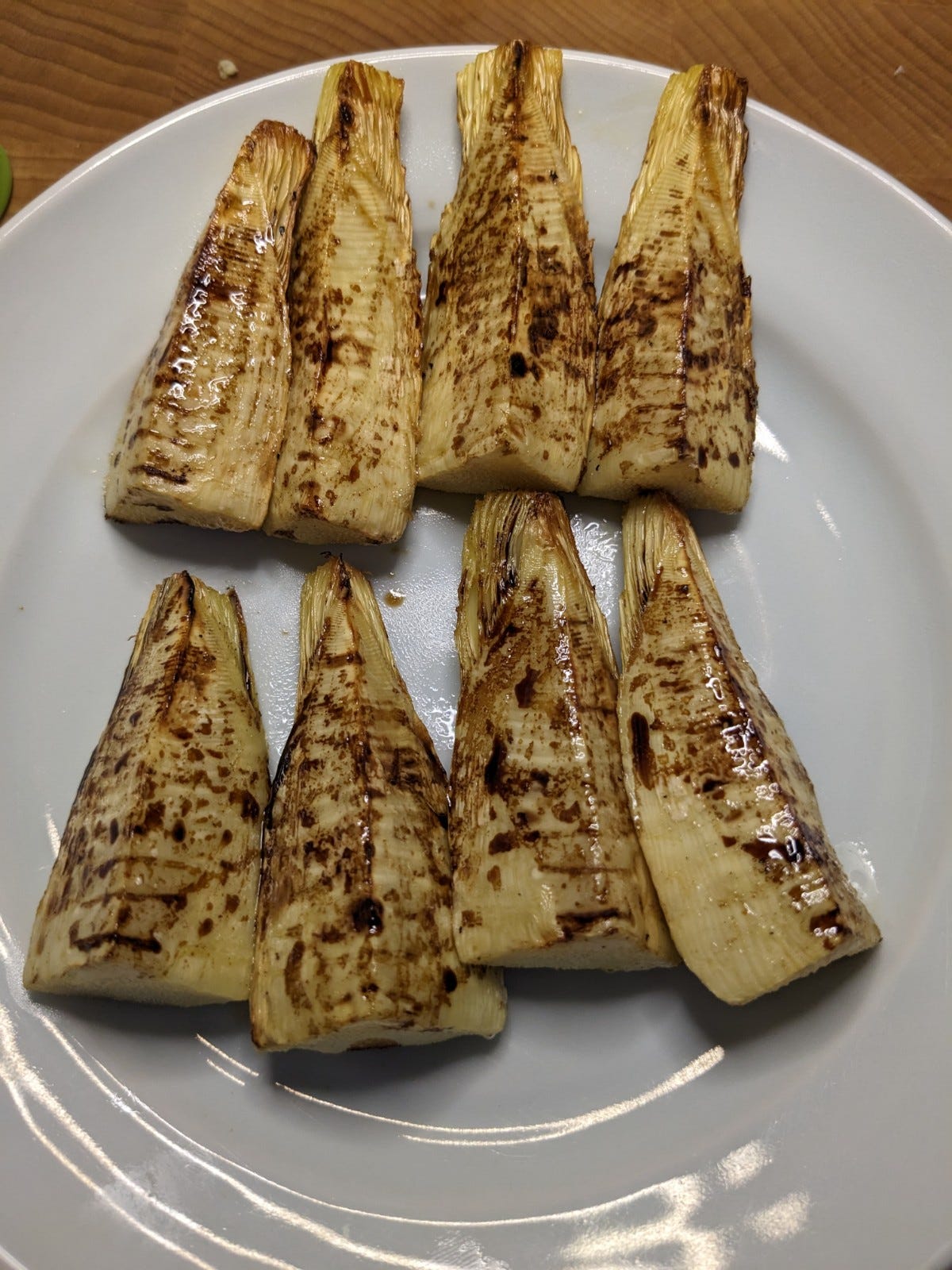Hello!
You’ve received this email because you’ve signed up for noodsletter. Thank you.
If any of you want to send over things you find interesting, or that you think I would find interesting, I encourage you to do so! (Thank you to all who do!)
No recipe this week, but as promised all the recipes ever published in noodsletter have been archived in the very first noodsletter, which you can find here.
Please consider becoming a paid subscriber!
Book Bit
One day you'll be blind like me. You'll be sitting here, a speck in the void, in the dark, forever, like me.
(Pause.)
One day you'll say to yourself, I'm tired, I'll sit down, and you'll go and sit down. Then you'll say, I'm hungry, I'll get up and get something to eat. But you won't get up. You'll say, I shouldn't have sat down, but since I have I'll sit on a little longer, then I'll get up and get something to eat. But you won't get up and you won't get anything to eat.
(Pause.)
You'll look at the wall a while, then you'll say, I'll close my eyes, perhaps have a little sleep, after that I'll feel better, and you'll close them. And when you open them again there'll be no wall any more.
(Pause.)
Infinite emptiness will be all around you, all the resurrected dead of all the ages wouldn't fill it, and there you'll be like a little bit of grit in the middle of the steppe.
From Endgame by Samuel Beckett. (There are many free versions of the English text available.)
Saw a production of this at the Irish Repertory Theater a couple weeks ago, which I didn’t really like (it got a good review in the NYT); seemed to me they played it too hard for laughs, but honestly, what the heck do I know. They’re streaming the last four performances live, if you’re interested.
Here’s the scene above in a 2000 production.
Work Stuff
Check out our huge sandwich package!
Bánh mì, McRibs, and grilled cheeses, with every single element made from scratch (including recipes for turning any cheese into a melty cheese slice? Yes!).
Pressing Salt Matters
I am almost 100% sure that Diamond Crystal Kosher Salt’s redesign of its packaging was accompanied by a change in the density of the salt crystals. I would like you to help me figure this out, if you can (I had meant to reach out to Cargill, the parent company, to ask about this, but I’d like a little data to back it up first).
The main reason you stick with specific salt brands is just so you can become accustomed to the density of the salt crystals; when you grab a “pinch,” it becomes a relatively accurate relative measure of how much salt you’d like to add to any given thing. Swap in a different brand of salt, which will invariably have a slightly different density due to the disparate production methods brands have, and your trusty “pinch” isn’t so trusty anymore.
Density in salt is a function of how small the salt crystals are; table salt has very fine-grained salt crystals; kosher salts have larger grained crystals. As a result, a tablespoon of table salt can have up to three times as much salt as a tablespoon of larger-grained salt.
I picked one of the new packages of Diamond Crystal Kosher Salt a couple weeks ago, and all my cooking has been off; my “pinches” are, if you excuse my terrible Spanish, pinche. All the salt has the consistency, the feel, of the last dregs of salt in the old Diamond Crystal Kosher Salt packages, almost powder-like, closer to sugar than cornmeal, if that makes sense.
It may seem odd to you but because I’ve worked for recipe websites for a while now, I’ve thought quite a lot about salt; and I’ve gotten into a fair number of arguments with my colleagues about salt. What’s long been at issue is the mass equivalent of 1 teaspoon (or tablespoon) of salt. Measuring spoons are far from standardized, and there is the inherent bit of inaccuracy in trying to make volumetric measurements line up in whole numbers with mass measurements.
For my part, every time I measured Diamond Crystal Kosher Salt using my measuring spoons (I have several different brands’ measuring spoons!), I got the following figures:
1 teaspoon Diamond Crystal Kosher Salt = ~4 grams
1 tablespoon Diamond Crystal Kosher Salt = ~12 grams
I just measured the new Diamond Crystal Kosher Salt, using three separate measuring spoon types/brands, and here’s what I got
1 teaspoon Diamond Crystal Kosher Salt = ~3 grams
1 tablespoon Diamond Crystal Kosher Salt = ~9.5 grams
So…this is significantly different!
If you are interested in this bit of salt pedantry, and you use Diamond Crystal Kosher Salt, and you own a digital scale accurate to 1 gram (0.1 gram is even better!), would you mind measuring out teaspoons and tablespoons of your salt and sending them to me? If you happen to have one of the old boxes, that would be even more amazing.
Extra credit if you weigh them each multiple times.
(Remember, when using measuring spoons, the ingredient must be leveled flush with the edge of the spoons!)
Thanks in advance to any who participate!
The Best Noodle Soup in NYC (and a Word About Its Cousins)
Yunnan Flavour Garden
5121 8th Ave, Brooklyn, NY 11220
The bowl of noodles I wake up craving more than any other in all of New York City isn’t a bowl of ramen or pho. It’s the Crispy Meat Sauce rice noodles at Yunnan Flavour [sic] Garden in Sunset Park. I think it’s the best bowl of noodle soup in the entire city.
The name of the noodle soup is a bit of a misnomer. There isn’t really “meat” to speak of; while there are bits and bobs of crispy fried pig skin (and usually an errant slice of pork loin), most of the protein in the soup consists of thinly sliced rounds of pig intestine, braised until completely slippery and tender. You can understand why they named it the way they did, since it sounds far more appealing than “slippery pig intestines noodle soup with a scattering of cracklings,” but the confusing name invariably leads the server to confirm that you in fact want to order a bowl of pig intestines noodle soup. The correct answer, always, is an emphatic “yes.”
I think I know what you’re thinking. I used to think it, too: “Yuck. I am not the biggest fan of offal. When I do eat offal, I like to eat livers; I like to eat hearts; I like to eat kidneys and thymus glands. What I do not like to eat is intestines.” I don’t know why I thought about offal like this, but I did. I think it’s a product of having grown up with one parent who was very squeamish about chewy textures, who preferred chicken breasts and tenderloins over something as innocuously delicious as braised shanks.
Turns out that while I’m not the biggest fan of offal, I like eating it quite a bit. I’m not an offal evangelist, but I think most people who claim to not like offal are hung up (like me) on the idea of eating organs, even if they have no hesitation at all when eating, say, the crispy skin on a chicken wing. (Skin is, after all, an organ, and the most delicious and plentiful one at that.) It’s the inner organs of beasts and fowl that hang them up.
If you’d like to give intestines a try, I recommend hoofing it over to Sunset Park and ordering the noodle soup. The soup itself is a mix of pork and chicken broth, quite heavily seasoned with white pepper, salt, and soy sauce, as well as the braising liquid from whatever the toppings are included. The braised pork, braised chicken, and braised lamb noodles all have similar flavor profiles—hints of star anise, black cardamom, sand ginger (maybe?), clove, and dark soy sauce—with added layers of flavor depending on the protein in question: the pork is sweeter, the chicken has a blander “meat” taste but a heavier hand on seasoning, the lamb is quite gamey. The Crispy Meat Sauce is the mildest of the lot, weirdly enough, although it has a bit of the unmistakable barnyard funk of intestines (inevitable, really, given what they are) and as a result the soup has the clearest, “cleanest” flavor. Cilantro and scallions give it a bit of freshness, and the whole thing can be improved by an addition of the powdered spice condiment (chili flakes and white pepper for the most part, with some five-spice) or the chili oil at every table.
(The other noodle soup toppings are good, too, but not as excellent as the intestines. I rarely drink alcohol now, but when I did, the texture of the intestines was a little too much for me to handle if I was rather hungover; I’d get the pork or lamb then. Yet another benefit of not drinking alcohol appears to be I’m always in the mood for the intestines noodle soup!)
There are a couple other things to order there: the cucumber salad is excellent, as are the hot and sour wontons. You can even order a noodle soup with the wontons added in, and you can get the hot and sour wontons with noodles: both are excellent moves, but I generally prefer to keep the two, perfect dishes separate so I can enjoy them separately (the wontons also keep quite well, so get them to go if you don’t finish them). If you are adventurous, the plate of stir-fried offal is pretty great, too.
There are some things I don’t recommend, and one of them is their signature item: the Crossing the Bridge Noodles. This is apparently a specialty of Yunnan, and it consists of a BIG bowl of boiling hot soup, which is brought to the table with noodles in a separate bowl and a platter of various mix-ins: thinly sliced meat or fish, wood’s ear mushrooms, fish cake, etc. For whatever reason, neither of the versions of Crossing the Bridge Noodles come anywhere close to being as good to eat as the noodle soups in the section on the menu just below.
The other items you should avoid are the non-“Rice” noodles, which fall in two categories: “Rice Stick” and “Wheat.” For whatever reason, the wheat noodles and the rice stick (basically banh pho) don’t work as well in the soup as the mixian, that is, the thick, tubular, spaghetti-like rice noodles that are the region’s specialty.
Funnily enough, the success of Yunnan Flavour Garden seems to have led to a kind of mini-mixian renaissance in the neighborhood. There are at least five other shops that sell similar noodles, and all of them cropped up after Yunnan Flavour Garden got a glowing write up in the NYT by Ligaya Mishan in 2014. (It’s a mystifying review: Mishan sort of pooh poohs the Crispy Meat Sauce noodles, praises the Crossing the Bridge Noodles, and, weirdest to me, claims the mixian are made in-house, which was and is very, very unlikely for extruded dried rice gel noodles.)
In subsequent noodsletters, I’ll recommend two other mixian-centric noodle shops in the area, one of which has a Crossing the Bridge Noodles that I think is good. In the interim, if you give Yunnan Flavour Garden a try, let me know what you think!
Oh and if this mixian business sparks your interest, a while back I did a little primer on making a noodle soup with them: check it out. They are perhaps my favorite type of noodle to eat at the moment.
The New York Times Comment Sections Are Deranged, Part 1 of Ten Billion
I was looking at the Pete Wells review of Kono, since I got treated to a meal there by one of my friend (and have a recap of the meal in noodsletter for paid subscribers), and…well someone should call the FBI.
This kind of late republican or early imperial Roman excess is why I no longer care if our country lives past the next virus.
Baby Bamboo
I ate this skewer of bamboo shoot tips at Kono, and it was one of the best bites I’ve had in my life.
While walking around a supermarket in Brooklyn Chinatown, I saw these bamboo shoot tips for sale; at ~$7 per pound, they were a little pricey, but I figured what the hell, even if I got half as much pleasure from them as the bite at Kono, it’d be a steal. I’d never prepared them before, but I did a little Googlin’ and the consensus seemed to be “peel, boil in salted, sugared water, slice, cook again.” (A week later the Instagram account of Noma Projects posted something about how you can cook them in a basic solution to get rid of their bitterness, interesting idea.)
I poached them for an hour, although they could have probably used a bit more, like 90 minutes, and then sliced them up, threw them on my electric grill, and brushed them with good tamari as they came off. As good as the one at Kono? No. But they were absolutely delicious.
They’re still in season; go grab some before they’re gone!
Why Do People Talk About Japanese Food Like This?
Hannah Goldfield had a piece in The New Yorker about Japanese breakfasts, which she immediately conflates with set meals, or teishoku, and it’s an excellent example of the bizarre way American food writers and American food media treat Japanese food and food culture.
Just look at the way some items are given their Japanese names (italicized, in the NYer style) and others aren’t. Teishoku is immediately defined as a set meal—yes, it is exactly like a meat and three—and then rather than use “set meal,” Goldfield uses the exotified “teishoku” incessantly. To describe a rolled omelette, Goldfield writes, “a square of slightly sweet, custardy tamago with caramelized edges,” which isn’t particularly insightful for someone unfamiliar with Japanese cuisine, and is kind of confusing for people who are familiar with Japanese cuisine, because tamago just means “egg”; it does not mean a rolled omelette. It’s not clear that Goldfield knows that, though, because a sentence later she writes, “On the side was miso soup and mixed-grain rice, to which I added a slippery poached egg bathed in sweet soy sauce.” Oh so now we’re just calling eggs “eggs”? Why isn’t “cucumber” rendered in romanized Japanese? Why not “eggplant?” Why “shiro-ae, or miso-tofu purée”?
As The New Yorker would put it, it’s all kabuki, or Japanese opera. But what is the show?
Goldfield starts by saying, essentially, these sorts of things were once the privilege of people who not only can jet off to Japan, but jet off to Japan and stay at a 5-star hotel. (Never mind that the thing she is talking about is the most quotidian of meals, made with the most quotidian Japanese ingredients; so quotidian, in fact, that I can buy most of them at my abysmal neighborhood Met grocery store: miso, tofu, salmon, even “tamago”!) She then notes that “for a long time” Okonomi in Williamsburg “was basically” the only place to get Japanese breakfasts in New York, boldly using “basically” as a synonym for “not”—Pan Ya existed for over two decades next to the old Sunrise Mart near St. Marks Place, but Goldfield also ignores the proliferation of the teishoku chain Ootoya in the city, which now has three locations, the first of which opened and was reviewed by The New Yorker in 2012!
The point of the piece is to highlight a recent boom in “Asian” set meals in trendier parts of Brooklyn (one of them is Korean), which is fine. Why it has to be framed in this way, as if the food is precious, as if eating this way is exotically luxurious, is mystifying. That this is a show editors think their readers want is worrying, particularly since there’s no mention of how crazy it is to be shelling out $30 for a breakfast you can make yourself for under $5 simply because it happens to be “Japanese.”
It also seems to do a disservice to Okonomi, which at least has some justification for its price point: It’s a tiny place that serves locally sourced fish. It’s physical limitations alone mean it’s hard to survive without a higher price point; that it serves stuff many of its diners wouldn’t bother picking out at the fish store, even if they could get it, is part of what’s so admirable about the operation.
“News”



Elephants can waylay sugar cane trucks, as a treat.
Sea stars—not starfish—are gonna save us from purple sea urchin. Although, if you can eat purple sea urchin, why can’t we save the red sea urchin AND get uni for less than $40 a tiny wooden flat?
Let’s eat the seaweed blob, too, or at least make a soup or stew out of it.
Ok so Toblerone has to take the image of the Matterhorn off of its packaging, but isn’t Toblerone itself modeled in the image of the Matterhorn?
Brunch continues to be bad. (If you like brunch, wonderful. I like diners and dim sum, but not brunch.)
Vegan sushi is…to be honest, I am mostly uninterested in attempts to veganize sushi, of all things, but Dennis Lee wrote this; I always click on his stuff.
The New Yorker profiles Jonathan Nunn.
Toxic fumes at that Brooklyn shuffleboard club…FOR TWO YEARS?! Always had a bad feeling about that place! (Everyone says this about these stories, but truly, I did.)
Who says the spirit of homegrown invention is dead?
I like this annotated menu idea in Grub Street, sort of like the Harper’s Annotations, but more light-hearted. Hope it evolves a bit more though.
If you eat a lot of iceberg, you’re welcome.
Kind of a crazy closing report in Eater: Pongsri in Midtown, Num Pang in Chelsea Market, and Dumpling Galaxy in Flushing all closed. These are some peak circa 2010 hot restaurants, all done and dusted. (Dumpling Galaxy had pretty good dumplings, but it was also just an excellent place for banquet-style Cantonese.)
Seed catalog fun for seed catalog time (right? ‘Tis spring!).

Yeast milk. Sounds good?
The “Italian food culture is the product of modernity” take doesn’t seem like it should be controversial at all? The same is true of every “national” cuisine right now, no matter how fetishized by people within the country.
The bit in here about Western food in Japan takes frames a similar view of Japanese food as “people don’t realize that a lot of Japanese food is actually relatively new.” Fair enough, but I think it skips over the fact that pre-US occupation, the Japanese government was blanketing the country with recipes for Western-style meals (which includes Chinese food).
Speaking of running fish stories, those guys who got caught cheating (very badly!) in the fishing tournament have pled guilty.









I don't know how or if it would make a difference, but it appears the old DC was manufactured in Minneapolis, Minnesota - and the new DC made in St. Clair, Michigan
I have a box of Diamond Crystal with the old design; bought sometime after Sept 2022. With a jeweler’s scale, 1 tsp weighed 3 grams and 1 tbsp weighed 9.8 grams.